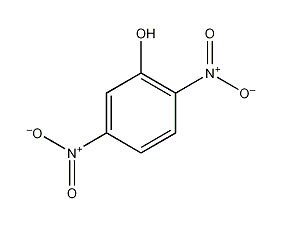
Structural formula
| Business number | 048P |
|---|---|
| Molecular formula | C6H4N2O5 |
| Molecular weight | 184.11 |
| label |
2,5-Dinitrophenol, 2,5-dinitrophenol, γ-dinitrophenol, γ-dinitrophenol, 2,5-dinitrophenol (water content ≥15%), 2,5-Dinitrofenol, 2,5-dinitro-pheno, 2,5-Dnp, gamma-dinitro-pheno, Phenol, 2,5-dinitro-, Phenol, gamma-dinitro-, γ-Dinitrophenol, GAMMA-DINITROPHENOL |
Numbering system
CAS number:329-71-5
MDL number:MFCD00007108
EINECS number:206-348-1
RTECS number:SL2900000
BRN number:None
PubChem number:28493584
Physical property data
1. Physical property data
Character: yellow needle crystal
Density (g/mL, 25/ 4℃): Not available
Relative vapor density (g/mL, air=1): Not available
Melting point (ºC): 106-109
Boiling point (ºC, normal pressure): Not available
Boiling point (ºC, 5.2kPa): Not available
Refractive index: Not available
Flash point (ºC): Not available
Specific rotation ( º): Not available
Autoignition point or ignition temperature (ºC): Not available
Vapor pressure (kPa, 25ºC): Not available Use
Saturated vapor pressure (kPa, 60ºC): Not available
Heat of combustion (KJ/mol): Not available
Critical temperature (ºC): Not available
Critical pressure (KPa): Not available
Oil and water ( Log value of the partition coefficient (octanol/water): not available
Explosion upper limit (%, V/V): not available
Explosion Lower limit (%, V/V): Not available
Solubility: soluble in ether; hot ethanol and benzene, slightly soluble in water. Can evaporate with water vapor.
Toxicological data
2. Toxicological data:
Acute toxicity: LD50: 150 mg/kg (rat intraperitoneal); 273 mg/kg (mouse intraperitoneal Inside) .
Ecological data
3. Ecological data:
1. Other harmful effects: This substance is harmful to the environment. Do not let this substance enter the environment. Special attention should be paid to the pollution of water bodies.
Molecular structure data
1. Molar refractive index: 41.22
2. Molar volume (cm3/mol): 111.5
3. Isotonic specific volume (90.2K): 333.2
4. Surface tension (dyne /cm): 79.6
5. Polarizability (10-24cm3): 16.34
Compute chemical data
1. Reference value for hydrophobic parameter calculation (XlogP): None
2. Number of hydrogen bond donors: 1
3. Number of hydrogen bond acceptors: 5
4. Number of rotatable chemical bonds: 0
5. Number of tautomers: 4
6. Topological molecule polar surface area 112
7. Number of heavy atoms: 13
8. Surface charge: 0
9. Complexity: 220
10. Number of isotope atoms: 0
11. Determine the number of atomic stereocenters: 0
12. Uncertain number of atomic stereocenters: 0
13. Determine the number of chemical bond stereocenters: 0
14. Number of uncertain chemical bond stereocenters: 0
15. Number of covalent bond units: 1
Properties and stability
None yet
Storage method
None yet
Synthesis method
Obtained from nitration of m-nitrophenol. Heat 40% nitric acid to 40°C, slowly add m-nitrophenol, and complete the addition in about 3 hours at 40-60°C. Then heat at 50-70°C for 1 hour, cool and pour off the dilute acid solution, pulverize the solid, wash with ice water to remove the acidity, and filter to dryness. The obtained product was dissolved in cold ethanol, and the insoluble material was 2,5-dinitrophenol.
Purpose
Used in organic synthesis. Used as an indicator in chemical analysis, its 70% ethanol solution is prepared into a 0.05-0.1% solution or its saturated aqueous solution is used as an indicator. The pH discoloration range is 4.0 (colorless) – 5.8 (yellow).

 微信扫一扫打赏
微信扫一扫打赏

